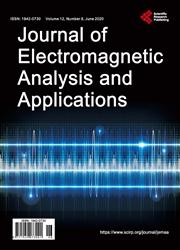A Qualitative Analysis of the Diameter of Long Positive Jet Streamer above Thundercloud in Uniform Atmosphere
引用次数: 0
Abstract
A qualitative analysis of the diameter of the spherical head of a long positive Jet streamer above thundercloud is presented in this paper under uniform atmospheric condition for streamers of less than 7 km length. In this study, an attempt is made to replicate laboratory-based point electrode discharge model for jet streamers originating above the thunderclouds. In laboratory conditions, it is not possible to produce huge electrode potentials which could be the reason that the streamers generated under the controlled lab environment have diameter of the order of only a few centimeter and length of a few millimeter. On the other hand, the thunderclouds carry huge electrical charges, for example 50 C, which can produce huge electrical potentials of the order of several hundred MeV. Such huge potential can act as the potential of a point electrode which may be capable of producing very large and thicker streamers above the thunderclouds. So, a leader mechanism of streamer initiation is assumed in calculations as the tip of conducting leader channel can act as point electrode carrying huge cloud potential to generate large streamers. It is found in this study that as the streamer moves larger distance away from the electrode (leader tip), the diameter of the streamer head decreases. Higher the potential of the electrode (leader tip), thicker is the streamer and more slowly the diameter decreases. Also, it is also found in our calculations that for higher electrode (leader tip) potential lower is the altitude of initiation of streamers.均匀大气中雷暴云上方长正喷流直径的定性分析
本文定性地分析了雷云上空长度小于7 km的长正射流流线在均匀大气条件下的球头直径。在这项研究中,试图复制基于实验室的点电极放电模型,用于雷雨云上方的射流流线。在实验室条件下,不可能产生巨大的电极电位,这可能是在受控的实验室环境下产生的流光的直径只有几厘米,长度只有几毫米的原因。另一方面,雷雨云携带着巨大的电荷,例如50摄氏度,这可以产生几百兆电子伏的巨大电势。如此巨大的电势可以作为点电极的电势,它可能能够在雷雨云上方产生非常大而厚的流光。因此,在计算中假设了一种导流起始的先导机制,即导流通道的尖端可以作为携带巨大云势的点电极产生较大的导流。本研究发现,随着流线离电极(导联尖端)的距离增大,流线头的直径减小。电极电位越高,流线越厚,直径减小越慢。此外,在我们的计算中也发现,对于较高的电极(引线尖端)电位,较低的流线起始高度。
本文章由计算机程序翻译,如有差异,请以英文原文为准。
求助全文
约1分钟内获得全文
求助全文

 求助内容:
求助内容: 应助结果提醒方式:
应助结果提醒方式:


